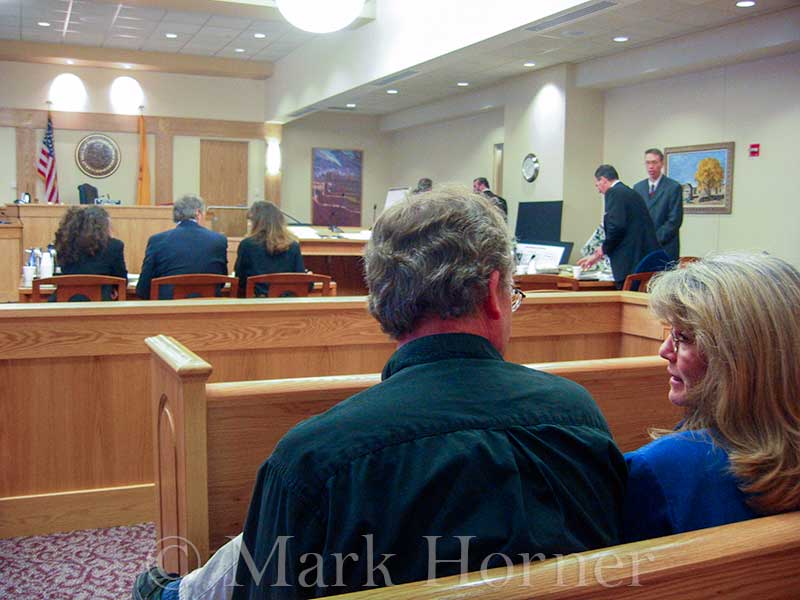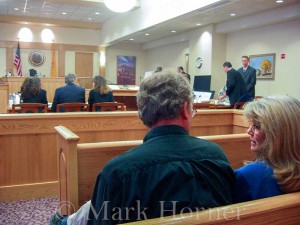Sensational testimony also emerges
(Albuquerque) After three years of hearing about a mysterious tarp containing Girly Chew Hossencofft’s blood-stained clothing, it was displayed for all to see in court Wednesday morning. The State made the dramatic presentation, revealing Ms. Hossencofft’s bloody blouse, her shorts and her panties. Prosecutors Paul Spiers and Jack Burkhead carefully unfolded the large tarp then laid it on the floor before the jury box. Blotchy areas of blood were clearly visible. And there was more.
Duct tape. Two pieces. One had strands of Ms. Hossencofft’s hair attached to it. The other piece of tape is shaped like a figure eight. “Like it had been wrapped around someone’s wrists,” speculated the State’s witness Raymond Gabaldon, the state highway worker who discovered the tarp, clothes and duct tape along Highway 60 a few miles west of Magdalena on the morning of September 10th, 1999. Prosecutors say Ms. Hossencofft had been kidnapped from her home in Albuquerque (about 125-miles away) the night before. They’re attempting to convince a jury that defendant Linda Henning is guilty of murder, kidnapping and 18 other crimes in this case. If convicted, Henning could become only the second woman in New Mexico history to receive the death penalty.
Prosecutors are attempting to establish that Henning’s boyfriend, Diazien Hossencofft, wanted his estranged wife dead. And that Henning helped execute the elaborate murder plot.
Presenting the tarp and clothing, though, exposed a weakness in the prosecution’s case according to Henning attorney Gary Mitchell
A State Police Patrolman called out to the scene testified it had rained the night before the tarp was discovered.
Mitchell says bank records prove Henning was at a Smith’s grocery story in Albuquerque just before midnight on September 9th. He contends Henning couldn’t have driven the two hour drive to the scene on Highway 60 in time for the passing rainstorm. Mitchell also contends that, if Henning had driven her Honda Accord in the rain on Highway 60 (or dirt roads near the highway), there should have been evidence of mud or dirt on the car. He says there was none.
State’s witness Vonda Cheshire, an administrative director for an adoption agency, provided dramatic testimony Wednesday. Cheshire explained that Diazien Hossencofft contacted the Triad Adoption Agency in the summer of 1999 claiming that he was dying of leukemia and that he wanted to find a new home for his three-year-old son as soon as possible. Cheshire says Mr. Hossencofft initially appeared quite sick and often seemed to be coughing up blood. Later, she says, she began to wonder if it was part of a big charade.
Early on, though, Cheshire says she pressed Hossencofft for information about the child’s mother. She says, ultimately, he claimed he had harvested eggs from a Japanese woman in Canada then returned to the US where he “created” the child in a laboratory. Cheshire says Hossencofft concluded this “fantastic” story by adding that the information about this remarkable achievement was stored on five gold disks.
(*note: police reports and transcripts previously obtained by this reporter demonstrate that Hossencofft conceived the child with a Japanese woman in Canada. The child was born in Japan. Shortly afterwards, Hossencofft–claiming that the infant suffered from a rare disease that only he truly understands–convinced the woman to bring the baby to Mexico and turn the child over to him. An FBI report states Hossencofft had the child smuggled into the US. Police records state Hossencofft brought the boy home, telling his wife, Girly, that he had adopted the child. Girly only learned that Diazien was the biological father shortly before her disappearance).
Cheshire says in late August of 1999, when the boy was three, Hossencofft asked her if Girly had signed papers relinquishing her rights to the child. After telling him, “Yes,” Cheshire says Hossencofft responded, “There’ll be justice.”
Cheshire says she was so troubled by her dealings with Hossencofft (she had given him rides in her car as he claimed he couldn’t drive and he’d suddenly become quite gruff once the adoption was approved) that she decided it was important to tell her husband (even though it violated confidentiality rules) about the case during dinner at an Albuquerque restaurant. She says a voice spoke-up from the table behind her. “Do you think you should be telling that story?” The voice came from Diazien Hossencofft. Moments later a woman joined Hossencofft at the nearby table. It was Linda Henning. Cheshire says she immediately recognised Henning because she’d often seen Henning coming-and-going from Hossencofft’s home. Cheshire says Hossencofft had previously told her Henning was with a leukemia foundation.
Cheshire says, fearing Hossencofft’s child might have been kidnapped, she contacted the FBI.
FBI Special Agent John Schum appeared on the stand Wednesday. He explained that he made his first contact with Girly on August 27, 1999. After a history of domestic violence, Girly had moved out of Hossencofft’s home in January, keeping the location of her small apartment a guarded secret. She was “very concerned about her welfare,” testified Schum, adding that she was living in “great fear of Mr. Hossencofft.”
Schum says Girly contacted him on September 8, 1999, once again expressing great fear. “Can you protect me?” Girly asked Schum. Because she hadn’t been recently contacted by her estranged husband, Schum explained there was nothing that could be done.
Girly Chew Hossencofft disappeared the following night.
The last witness to take the stand Wednesday was former Diazien Hossencofft girlfriend Julie McGuire. She told a gripping tale.
McGuire says Hossencofft conned her out of thousands of dollars, claiming to be a doctor and giving her injections that he said would keep her from aging. She also says, initially, she had no idea he was married. Eventually, she says she caught-on to his scheme. But rather than running or confronting him, she decided to play along and stay quiet. She says her decision to do so stemmed out of her concern for Hossencofft’s young son. McGuire says she’d become attached to the boy and came to believe Diazien Hossencofft had been abusing him.
While enduring Hossencofft’s affections despite her growing disgust for him, McGuire says he ultimately shared his plot to murder Girly. McGuire says Hossencofft confided that he was going to pay to have a person kill Girly and that no one would ever find a body. She says she told him, “But people go missing all the time and someone usually finds the body.” To that, she says Hossencofft responded, “Not if they’re dissected.”
McGuire is expected to continue testifying when court resumes at nine o’clock Thursday morning.



